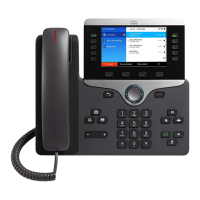• on
i,j
and off
i,j
are the on/off duration in seconds of a segment. i = 1 or 2, and j = 1 to 6.
• D
i
is the total duration of the section in seconds.
All durations can have up to three decimal places to provide 1 ms resolution. The wildcard character “*”
stands for infinite duration. The segments within a section are played in order and repeated until the total
duration is played.
Example 1:
60(2/4)
Number of Cadence Sections = 1
Cadence Section 1: Section Length = 60 s
Number of Segments = 1
Segment 1: On=2s, Off=4s
Total Ring Length = 60s
Example 2—Distinctive ring (short,short,short,long):
60(.2/.2,.2/.2,.2/.2,1/4)
Number of Cadence Sections = 1
Cadence Section 1: Section Length = 60s
Number of Segments = 4
Segment 1: On=0.2s, Off=0.2s
Segment 2: On=0.2s, Off=0.2s
Segment 3: On=0.2s, Off=0.2s
Segment 4: On=1.0s, Off=4.0s
Total Ring Length = 60s
• DialPlanScript—Scripting syntax that is used to specify Line 1 and Line 2 dial plans.
• Float<n>—A floating point value with up to n decimal places.
• FQDN—Fully Qualified Domain Name. It can contain up to 63 characters. Examples are as follows:
• sip.Cisco.com:5060 or 109.12.14.12:12345
• sip.Cisco.com or 109.12.14.12
• FreqScript—A miniscript that specifics the frequency and level parameters of a tone. Contains up to 127
characters.
Syntax: F
1
@L
1
[,F
2
@L
2
[,F
3
@L
3
[,F
4
@L
4
[,F
5
@L
5
[,F
6
@L
6
]]]]], where:
• F
1
–F
6
are frequency in Hz (unsigned integers only).
• L
1
–L
6
are corresponding levels in dBm (with up to one decimal place).
White spaces before and after the comma are allowed but not recommended.
Example 1—Call Waiting Tone:
440@-10
Cisco IP Phone 8800 Series Multiplatform Phone Administration Guide for Release 11.3(1) and Later
94
Cisco IP Phone Provisioning
Data Types

